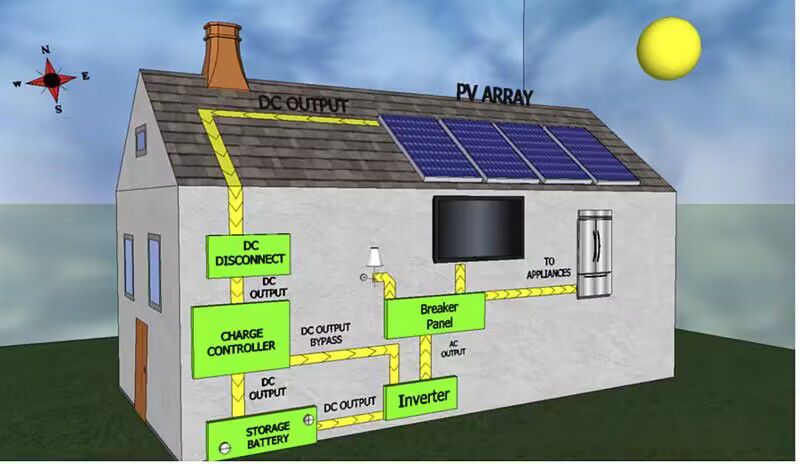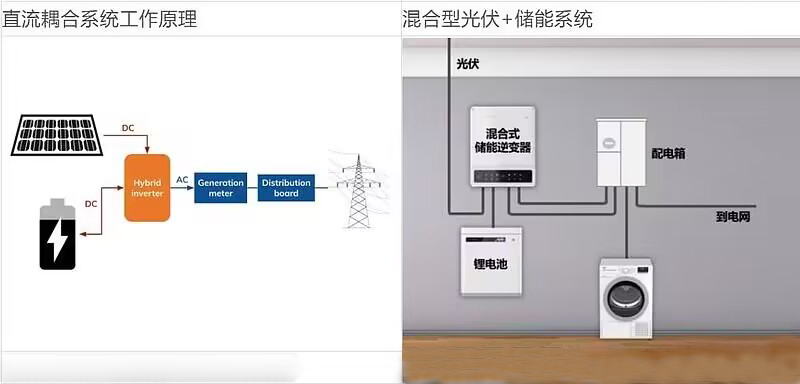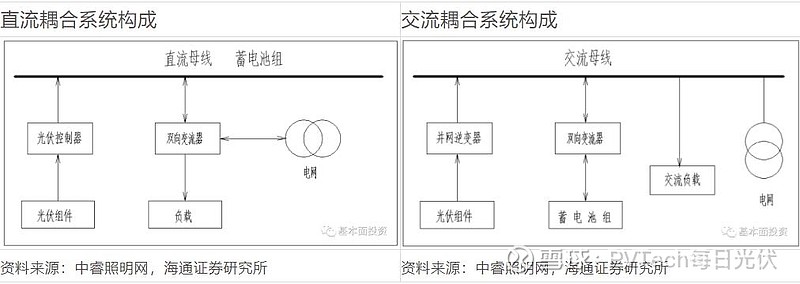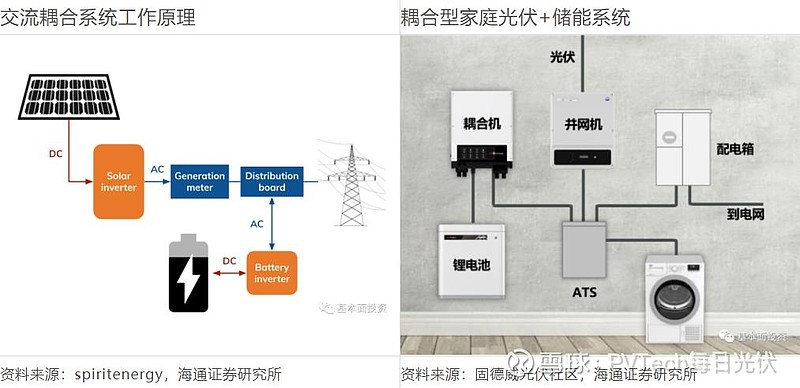Photovoltaic storage system, including solar modules, controllers, inverters, batteries, loads and other equipment. At present, there are mainly two technical routes of DC coupling and AC coupling. AC or DC coupling refers to the way in which solar panels are coupled or linked to energy storage or battery systems. The type of connection between solar modules and batteries can be AC or DC. Most electronic circuits use direct current, solar modules generate direct current, and batteries store direct current, yet most appliances run on alternating current.

Hybrid photovoltaic + energy storage system, that is, the direct current generated by photovoltaic modules is stored in the battery pack through the controller, and the grid can also charge the battery through a bidirectional DC-AC converter. The gathering point of energy is at the DC battery end. During the day, the photovoltaic power generation first supplies the load, and then charges the battery through the MPPT controller. The energy storage system is connected to the grid, and the excess power can be connected to the grid; at night, the battery is discharged to supply the load, and the insufficient part is supplemented by the grid; And lithium batteries only supply power to off-grid loads, and grid-connected loads cannot be used. When the load power is greater than the PV power, the grid and PV can supply power to the load at the same time. Because photovoltaic power generation and load power consumption are not stable, it is necessary to rely on the battery to balance the energy of the system. In addition, the system also supports the user to set the charging and discharging time to meet the user's electricity demand.

The hybrid inverter integrates off-grid functions to improve charging efficiency. Grid-tie inverters automatically shut off power to the solar panel system during a power outage for safety reasons. Hybrid inverters, on the other hand, allow users to have both off-grid and grid-connected capabilities, so they can use power even during blackouts. Hybrid inverters simplify energy monitoring, and vital data such as performance and energy production can be checked through the inverter panel or connected smart devices. If the system has two inverters, they must be monitored separately. DC coupling reduces losses in AC-DC conversion. Battery charging efficiency is about 95-99%, compared to 90% for AC coupling.
Hybrid inverters are economical, compact and easy to install. Installing a new hybrid inverter with DC-coupled batteries may be less expensive than retrofitting AC-coupled batteries to an existing system, as controllers are less expensive than grid-tied inverters, and transfer switches are less expensive than distribution cabinets, The DC coupling scheme can also be made into a control and inverter integrated machine, which can save equipment costs and installation costs. Especially for small and medium power off-grid systems, the DC coupling system is very cost-effective. The hybrid-inverter has a high degree of modularity, and it is easy to add components and controllers, and additional components can be easily added using a relatively low-cost DC solar controller. And hybrid inverters are designed to integrate storage at any time, making it easier to add battery packs. The hybrid-inverter system is more compact, uses high-voltage batteries, and the cable size is smaller and the loss is lower

However, hybrid inverters are not suitable for upgrading existing solar systems, and systems with higher power are more complicated to install and more expensive. If a user wants to upgrade an existing solar system to include battery storage, choosing a hybrid inverter can complicate the situation, while battery inverters can be more cost-effective, because choosing to install a hybrid inverter requires the entire solar panel A complete and expensive rework of the system. Higher power systems are more complex to install and more expensive due to the need for more high voltage controllers. If a lot of electricity is used during the day, the efficiency will drop slightly due to DC (PV) to DC (batt) to AC.
The coupled photovoltaic + energy storage system, also known as the AC modified photovoltaic + energy storage system, can convert the direct current generated by the photovoltaic module into alternating current through the grid-connected inverter, and then pass through the AC-coupled energy storage inverter to convert the redundant The electricity is converted into direct current and stored in the battery, and the collection point of energy is at the AC end. Including photovoltaic power supply system and battery power supply system. The photovoltaic system consists of photovoltaic arrays and grid-connected inverters, and the battery system consists of battery packs and bidirectional inverters. These two systems can operate independently without interfering with each other, or they can be separated from the large power grid to form a micro-grid system

The AC coupling system is 100% compatible with the grid, easy to install and easy to expand. Standard household installation components are available, and even relatively large systems (2KW to MW class) are easily expandable, and can be combined with grid-connected and stand-alone generator sets (diesel sets, wind turbines, etc.). Most string solar inverters above 3kW have dual MPPT inputs, so long strings of panels can be installed with different orientations and tilt angles. At higher DC voltages, AC coupling is easier and less complex and therefore less costly to install large systems than DC coupled systems requiring multiple MPPT charge controllers.
AC coupling is suitable for system modification, and it is more efficient to use AC loads during the day. The existing grid-connected photovoltaic system can be transformed into an energy storage system with low input cost. When the power grid is out of power, it can provide users with safe power guarantee. Compatible with grid-connected photovoltaic systems from different manufacturers. Advanced AC-coupled systems are often used in larger scale off-grid systems and use string solar inverters in combination with advanced multi-mode inverters or inverter/chargers to manage the battery and grid/generator . Although relatively simple to set up and powerful, they are slightly less efficient at charging the battery (90-94%) compared to DC-coupled systems (98%). However, these systems are more efficient when powering high AC loads during the day, reaching over 97%, and some systems can also be expanded with multiple solar inverters to form a microgrid.
AC-coupled charging is less efficient and more expensive for small systems. The energy that goes into the battery in AC coupling has to be converted twice, and when the user starts using that energy, it has to be converted again, adding more losses to the system. Therefore, when using a battery system, the AC coupling efficiency drops to 85-90%. AC-coupled inverters are more expensive for small systems.
The off-grid household photovoltaic + energy storage system generally consists of photovoltaic modules, lithium batteries, off-grid energy storage inverters, loads and diesel generators. The system can realize photovoltaic directly charging the battery through DC-DC conversion, and can also realize bidirectional DC-AC conversion for charging and discharging the battery. During the day, the photovoltaic power generation first supplies the load, and then charges the battery; at night, the battery discharges to supply the load, and when the battery is insufficient, the diesel generator supplies the load. It can meet the daily electricity demand in areas without grid. It can be combined with a diesel generator, so that the diesel generator can supply the load or charge the battery. Most off-grid energy storage inverters do not have grid-connection certification, and even if the system has a grid, it cannot be connected to the grid.